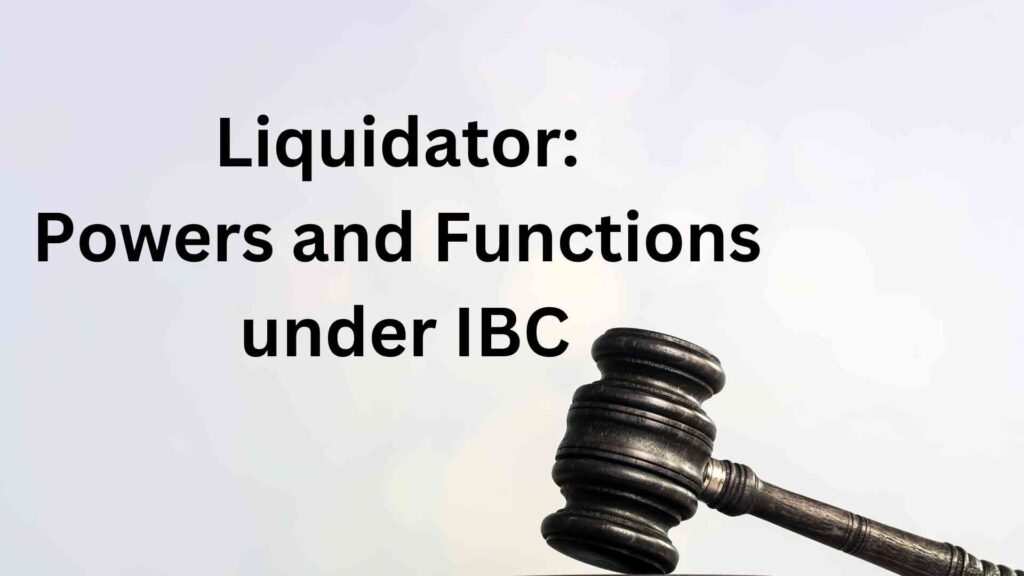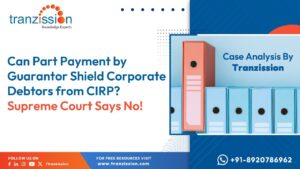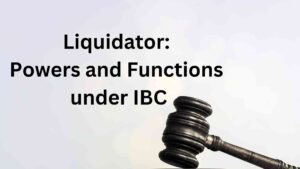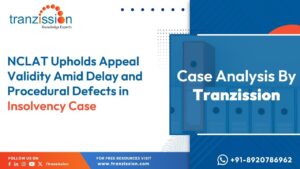
Liquidator: Powers and Functions under IBC

Table of Contents
A Liquidator: Powers and Functions under IBC, with reference to section 5(18) of the Insolvency and Bankruptcy Code, 2016 (hereon forward known as “the Code”), is an insolvency professional who is appointed by the court, which in insolvency law, is the National Company Law Tribunal (NCLT) to manage a company’s liquidation process when it is about to go bankrupt. The liquidator has the main role of selling the company’s assets, paying the creditors of the company, and distributing the remaining funds to shareholders
How and Who Appoints the Liquidator?
The involuntary liquidation process starts when the resolution plan has not been received by the NCLT or has rejected the resolution process as under section 33. When the NCLT passes an order for liquidation of a corporate debtor under the corporate insolvency resolution process (CIRP), the resolution professional (RP) that was appointed during the CIRP, is appointed as the liquidator for the liquidation process. Referring to section 34(1) of the Code, the liquidator is appointed by the NCLT. In voluntary liquidation process, as per section 59(3)(c) of the Code, when the corporate debtor is not going through the insolvency resolution process, the company members, after passing a special resolution, the insolvency professional (IP) is appointed as the liquidator by the company members.
At Any Stage of the Liquidation Process, Can the Liquidator be Replaced?
Yes, as per section 34(5), the liquidator can replace at any stage of the liquidation process by using the same process that was used for the initial appointment. Referring to section 16 of the General Clauses Act, 1897 and sections 33 and 34 of the Code, the NCLT has the power to replace the liquidator.
The NCLT can take the refer to the Insolvency and Bankruptcy Board of India (IBBI)to propose a name for the replacement within 10 days According to the Code and the NCLT, the liquidator can be replaced due to failure of the resolution plan to meeting the necessary statutory requirements under the Code, on the recommendation of the IBBI, misconduct, fraud or misfeasance, professional incompetence, failure to exercise due care and diligence, or causing any loss or damage to the company.
Read more : Difference between insolvency professional and registered valuer
What are the Powers and Duties of Liquidator
Section 35 of the Code, lists the ‘Powers and Duties of the Liquidator’. These powers and duties are listed down below:
- The liquidators have the duty of verifying the claims of all the creditors as per section 35(1)(a).
- As per Section 35(1)(b), the liquidator has the power to take custody and control of all assets, properties, effects and actionable claims of the corporate debtor.
- The liquidator has the duty under Section 35(1)(c) to evaluate the corporate debtor’s assets and property according to the IBBI’s guidelines and prepare a report accordingly.
- As Section 35(1)(d), the liquidator has the duty to protect and preserve the assets and properties of the corporate debtor.
- The liquidator has the power to continue the business of the corporate debtor, if necessary for its beneficial liquidation as under Section 35(1)(e).
- The liquidator has the power to sell the immovable and movable property and actionable claims of the corporate debtor, subject to section 52 which relates to the liquidation process of secured creditors.
- The liquidator has the power to handle the financial transactions of the corporate debtor under Section 35(1)(g). Hence, the liquidator can draw, accept, make and endorse negotiable instruments in the name of the corporate debtor.
- As listed under Section 35(1)(h), the liquidator has administrative duties as well, which includes, the duty to take out letters of administration for the deceased contributors and perform other necessary acts for the recovery of money due to the corporate debtor.
- The liquidator, as under Section 35(1)(i), has the power to obtain professional assistance or appoint experts to help in fulfilling their duties.
- The liquidator has the duty for the settlement of claims and distribution of proceeds as given under Section 35(1)(j)
- The liquidator has the power to handle the legal actions of the corporate debtor as per Section 35(1)(k), which means that the liquidator has the power to initiate, defend legal proceedings on behalf of the corporate debtor to address any pending legal issues or claims, whether it may be of civil or criminal nature.
- The liquidator has the duty to investigate the financial affairs of the corporate debtor to identify any undervalued or preferential transactions.
- Under Section 35(1)(m), the liquidator has the duty to take all the necessary actions, steps and to sign, execute, and verify any document, application, or petition that was required for the liquidation.
- Under Section 35(1)(n), the liquidator can make an application to the NCLT for the necessary orders or directions and must report the progress of the liquidation process.
- As per Section 35(2), the liquidator has the power to consult any stakeholder relating to the distribution under section 53, though this consultation is not binding. It is important that records of these consultations be made available to all stakeholders. The liquidator is required to document all consultations with the stakeholders as under Regulation 8 of the Insolvency and Bankruptcy Board of India (Liquidation Process) Regulations, 2016 (hereon forward known as “Liquidation Process Regulations”) in the prescribed Form A of Schedule II.
Read more : How to crack insolvency examination
What Other Powers and Duties does the Liquidator have?
Other Liquidator: Powers and Functions under IBC include:
- The liquidator has the power to access any information systems under section 37, for the purpose of verification of claims and for the identification of assets that form part of the liquidation estate of the corporate debtor from sources as mentioned under section 37(1), information utility, credit information systems, Central and State Government Agency, and any database maintained by the IBBI.
- As given under Section 40 of the Code, the liquidator has the power admitting or rejecting the claims of the debtor.
- As given under section 43 of the Code, the liquidator has the power to evaluate any preferential transactions that were done by the corporate debtor.
- The liquidator has the power to distribute the assets as per priority given under section 53.
- The liquidator has the power to make an application to the NCLT under section 54(1) for the dissolution of the corporate debtor.
Other Liquidator: Powers and Functions under IBC which have not been explained above, have been mentioned in section 35(1)(o) where the term ‘other functions’ that have been specified by the Board are listed under Chapter III of the Liquidation Process Regulations. To have a better understanding of these Liquidator: Powers and Functions under IBC let us explain each in more detail:
- Under Regulation 5, the liquidator has the function to prepare and submit a preliminary report, asset memorandum, progress reports, sale reports, minutes of consultation with stakeholders, and the final report prior to dissolution.
- As per Regulation 6, the liquidator has the duty to maintain all the registers and books of account related to the liquidation and preserve them for 8 years after the dissolution of the corporate debtor, such as, cash book, ledger, register of fixed assets and inventories, etc.
- The liquidator under Regulation 7, may appoint professionals to assist the liquidation process. However, this professional should not be a related party to the corporate debtor, or has been an auditor to the corporate debtor in the 5 years preceding the liquidation commencement date (LCD).
- Under Regulation 9, the liquidator has the power to compel individuals, who are connected to the corporate debtor, such as former officers’ employees, auditors, or those in possession of properties, by making an application to the NCLT.
Claims Submitted by the Creditor
Once the liquidation process is initiated under section 33 of the Code, the creditors are prompted to submit their claims. The financial creditors of the corporate debtor submit their claims and proof of the claims to the liquidator in Form D of Schedule II of the Liquidation Process Regulations as given under section 38(2) of the Code. The operational creditor may submit a claim to the liquidator as under section 38(3) of the Code and the proof claim in person, by post, or by electronic means in Form C of Schedule II Under section 38(5) the creditor has the duty to withdraw or vary him claim within 14 days of its submission. Under section 39(1) of the Code, the liquidator has the duty to verify the claims, within 30 days from the last date of receipt, under which the liquidator may either admit the claims, or reject the claims. If the claim has been rejected, the liquidator must notify the creditor of such a decision and provide the reasons for doing so in writing as given under section 40(2) of the Code. If the creditor is not satisfied with the rejection of claims by the liquidator, the creditor can apply for an appeal to the NCLT within 14 days of receiving such a decision.
Read more : Duties of an Insolvency Professional
Conclusion
With the main role of selling the company’s assets, settling claims, and distributing proceeds, the Code and Liquidation Process Regulations have provided the liquidator many powers to guarantee the fairness and efficiency of the liquidation process. The liquidator also has duties as well, from verifying the creditors claims of the corporate debtor, managing the debtor’s assets and taking legal actions representing the corporate debtor, which are governed by strict legal frameworks. This process for liquidation is transparent, ensuring that the parties involved in the process are adequately protected, providing the ability to replace the liquidator, if found necessary.





